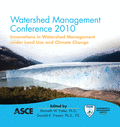How the Application of Environment Site Design Strategies and Low Impact Development Storm Water Treatment Systems Can Mimic the Natural Hydrologic Conditions in a Watershed and Provide a Resource for Carbon Sequestering
Publication: Watershed Management 2010: Innovations in Watershed Management under Land Use and Climate Change
Abstract
This paper will discuss how the application of Environmental Site Design Strategies (ESD) and the application of Low Impact Development (LID) storm water treatment can not only mimic the pre-development runoff curve number, but also remove non-point source pollutants from post-development runoff. ESD requires that civil engineers completely reevaluate the processes that they use to design a residential subdivision. ESD requires that the civil engineer evaluate the topography, soils, hydrology, vegetation and habitat on the site prior to the site design. This presentation will outline the necessary steps to evaluate the environmental parameters of the site prior to the design of a project. The environmental parameters to be evaluated include wetlands/watercourses/vernal pools, flood plains, steep slopes (generally >25%), unusual trees or vegetative systems, soils with high or moderate infiltration abilities, and other natural features. The ESD process is critical to achieving the LID goal of Hydrologic Transparency. By the implementation of LID treatment systems to treat runoff at its source, volumetric changes in runoff can be reduced and pollutants associated with non-point source runoff can be reduced through sedimentation, filtration, absorption and various chemical and biological reactions. Through the preservation of large extents of natural vegetated systems on a site, an additional environmental benefit can also be achieved. The preservation of large, contiguous areas of woodlands will provide a natural environment for the sequestering of carbon and the release of oxygen to the atmosphere. Lastly, this paper will show how the changing of the current development paradigm of prescriptive regulations to one utilizing ESD and LID, many of the adverse environmental impacts associated with development can be minimized while providing positive environmental benefits.
Get full access to this article
View all available purchase options and get full access to this chapter.
Information & Authors
Information
Published In
Copyright
© 2010 American Society of Civil Engineers.
History
Published online: Apr 26, 2012
ASCE Technical Topics:
- Business management
- Carbon fibers
- Engineering materials (by type)
- Environmental engineering
- Fibers
- Hydrologic engineering
- Hydrology
- Materials engineering
- Pollution
- Practice and Profession
- River engineering
- River systems
- Stormwater management
- Sustainable development
- Water and water resources
- Water management
- Water policy
- Water pollution
- Water resources
- Water treatment
- Watersheds
Authors
Metrics & Citations
Metrics
Citations
Download citation
If you have the appropriate software installed, you can download article citation data to the citation manager of your choice. Simply select your manager software from the list below and click Download.
